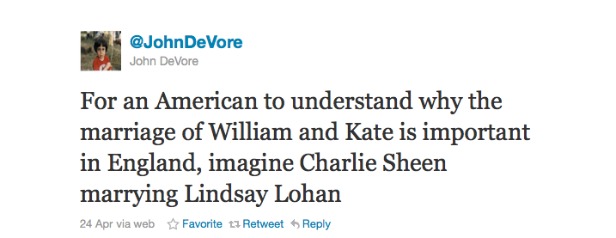As you may know, Twitter co-founder Biz Stone launched a new app called Jelly this week after about a year in stealth mode. It’s billed as “a new way to search,” but is essentially a Q&A service that lets you take pictures and tap into your Facebook and Twitter networks to seek answers.
The Jelly reviews have been very mixed so far, and many are simply wondering what real-world use we could possibly get out of it. But that attitude is accompanied by the acknowledgement of the people behind it and the fact that there was a very similar attitude surrounding Twitter in its early days. Now it’s a major part of Internet life and a publicly trade company, so one has to wonder if there’s more to Jelly than meets the eye.
Can Stone repeat the success of Twitter with Jelly? Do you think Jelly has potential to be a major app? Have you tried it yet? Do you intend to keep it on your phone? Let us know your first impressions in the comments.
The main idea behind Jelly, as pitched in the company’s introductory video, is that you see something that you don’t know what it is, take a picture of it, and find out from the people you’re connected to (or the people that are connected to the people you’re connected to) on Twitter and/or Facebook. You’re supposed to be able to tap into the collective knowledge of these networks for real, legitimate, and personally relevant answers.
Introducing Jelly from Jelly Industries, Inc. on Vimeo.
“What it’s doing is it’s going out there and pulling knowledge – things that your friends and their friends – they know, and that’s a key difference, because knowledge is very different from information,” says Stone in the video. “People will be eager to help each other on Jelly because we are driven to help.”
As I said, reviews are mixed.
MarketWatch says it “does not seem to be that novel of an idea.”
Sam Biddle at Gawker’s Valleywag calls Jelly “a revolution in engorged, cloying, dumbstruck rhetoric, a true disruption of horse shit,” and “an app for the sake of apps—a software Fabergé egg.”
My own knee-jerk reaction after playing around with the app for a few hours consisted of a handful of gripes (and I’ll look past the part about it locking up my phone here):
- The very concept: Why do I really need this? How often am I faced with circumstances that require me to take a picture of something to seek out information about it, let alone specifically from people who happen to be in my extended network? Not very often. I learned this after having the Google Goggles app downloaded for a long time without ever using it a single time beyond playing around with it to see what it could do. I’m sure there are circumstances where it could be helpful, but I just don’t see needing it enough to justify the app taking up storage on my phone.
- The barrage of dumb and irrelevant questions. Download Jelly and play around with it, and you’re likely to see many of these. It’s already a pit of noise. This could be solved with some kind of organization, which could come later, but right now, it’s just a flow of random questions – most of which I have no interest in beyond testing out the app. It’s not something that’s going to make me want to come back repeatedly.
- The notifications. Since downloading Jelly, my phone has been blowing up with notifications from the app. Some of these come from people answering my own questions, and that’s fine. That’s what it should do. More of them, however, are simply notifying me about more random questions from seemingly random people. I don’t need to know about these questions unless they pertain directly to me (which they don’t so far). If we could understand a bit more about what determines when Jelly targets specific people with specific questions perhaps we would find some more logic in this approach. For now, it’s just annoying.
Jelly counts Jack Dorsey, Evan Williams, Bono, Reid Hoffman, Steven Johnson, Al Gore, Gret Yaitanes and Roya Mahboob as investors – an interesting ensemble to say the least. These aren’t dumb people. Clearly they see something big in this concept.
“Jelly is one of the investments that I am most excited about,” Yaitanes told Fortune. “I invested in it because I loved the idea from its initial concept through its execution. I look at the people and I look at the team, sometimes more than I look at the product. I look at the passion. I have invested in good people before, and the startup went bust. But I would still go back to those entrepreneurs in a heartbeat when they have something else, because I know they have the makings of a good company when all the stars line up.”
“When I look at Jelly, I see what I saw in Twitter so many years ago. It is astounding,” he said. “Now that it is out in the world, it will only further its potential. Jelly 1.0 is just the beginning.”
Johnson also shared some thoughts about it in a blog post, basically positioning it as a place to get answers you can’t get from Google.
“‘How much is the new Battlefield 4 game?’ is a great question for Google,” he writes. “‘Is the Battlefield 4 game appropriate for a ten-year-old?’ is a great question for Jelly. Not because it’s going to link you to some review page on Commonsense Media, but because it’s going to connect you to another parent with a ten-year-old who has played Battlefield 4 — someone you know, directly or indirectly.”
“The thing that’s most surprising about Jelly is how fun it is to answer questions,” he says. “There’s something strangely satisfying in flipping through the cards, reading questions, scanning the pictures, and looking for a place to be helpful. It’s the same broad gesture of reading, say, a Twitter feed, and pleasantly addictive in the same way, but the intent is so different. Scanning a twitter feed while waiting for the train has the feel of ‘Here we are now, entertain us.’ Scanning Jelly is more like: ‘I’m here. How can I help?’”
Not quite the experience I had, but okay.
“Sure at first, people are going to say, ‘Hey, is this my foot?’” Stone told the LA Times. “But, hopefully, with time people will realize there are certain kinds of questions that are better suited to asking a person. Algorithms can retrieve all kinds of fancy information. But a person can also do something in two seconds that artificial intelligence would take the next 50 years to figure out. I am a big sci-fi fan but when people tout artificial intelligence, I joke, ‘How about just intelligence?’ There are 7 billion people on the planet. There is bound to be somebody who is going to help you out.”
If you spend any amount of time using Jelly, you’ll notice that its not a very effective two-way communication platform. You ask a question and get answers. You can’t comment back on the answers other than to mark it with a “thank you”. Stone told the Times they intentionally designed it to “not be very conversational.”
“Early prototypes sort of mimicked how a lot of stream-based or timeline-based social media applications work, and we found that we were encouraging a lot of similar behavior,” he said. “That isn’t bad. But if I posted a picture of my son wearing a hat to protect himself from the sun and asked if this was a good sun hat for my kid, a lot of people would respond saying, ‘He’s so cute,’ or ‘He looks like you,’ or ‘He looks like his mom,’ or ‘What a cutie.’ And I would say, ‘But what about the hat? Hello?’”
So they designed it a different way, which he says “works more like a search engine.”
It doesn’t have a search function, however, which in my opinion make it less helpful. It kind of seems like a waste of knowledge, because maybe someone has already asked your question. You have no way of knowing. This places limits on the likelihood that you’ll get a helpful answer – limited by your extended networks. Maybe the better answer came from outside of your extended networks. You just never got to see it.
This also potentially raises a reputation management issue for businesses. You have no way of monitoring your brand on Jelly. You can’t search to see who’s talking about it, though the content is public (or at least semi-public). You have no idea who is seeing these mentions of your brand or what they’re saying unless Jelly happens to show it to you.
While things may change in the future, there doesn’t appear to be much businesses can do with Jelly at all unless they happen to come across questions that are relevant to them. There’s not a clear revenue source with Jelly, though monetization efforts may not be a big priority. Stone said last year that they were in no rush to be a big company anytime soon. It does count Kevin Thau, once VP of Business Development at Twitter as its COO.
While Jelly is only for mobile platforms like Android and iOS so far, it’s possible that we’ll see a web version one day, similar to what we have with Instagram and now Vine.
Jelly exchanges do live on the web at their own URLs. Perhaps embeddable “jellies” will one day be in the cards.

We can try, but the fact is we can’t really judge an app or a business this early in its existence. You have to wait and see how people use it. If there is a way for businesses to use it, you can bet they will. Even if first impressions of Jelly leave a little (or a lot) to be desired, just remember what everyone was saying about Twitter when it came out.
What do you think about Jelly? Do you see a business use case? Do you think it will gain a significant user base? Share your thoughts in the comments.





















